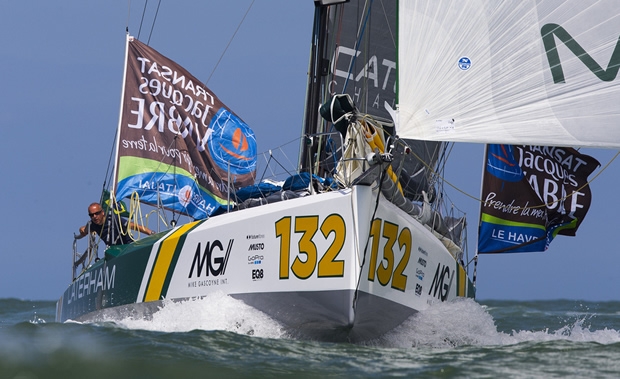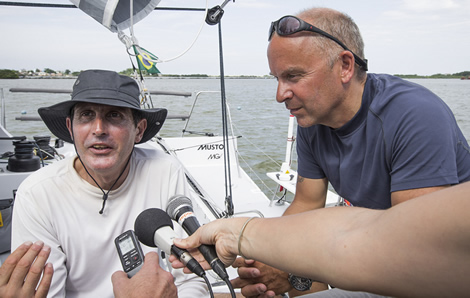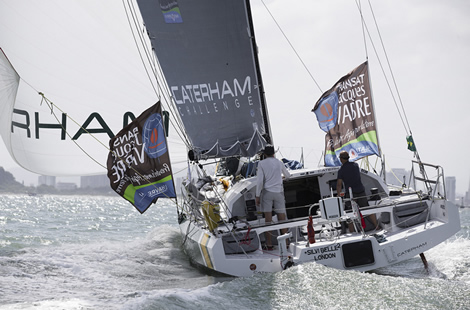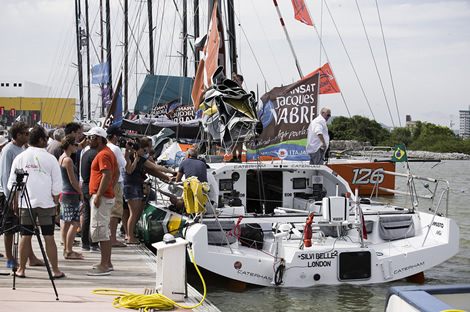
Caterham Challenge home in 14th
Britain’s fastest round the sailor Brian Thompson and ocean racing rookie Mike Gascoyne finished the Transat Jacques Vabre in 14th place in the Class 40 aboard Caterham Challenge. They arrived at 17:50 UTC after racing for 23 days 16 hours 36 minutes and 10 seconds. Their course sailed is 5711 miles and they completed it an average of 10.04 knots.
Gascoyne and Thompson sailed for four days with little or no mainsail and then finally had to pitstop in Recife for 12 hours to make a repair to their mainsail which they had already repaired on board five times and which had finally given up in the brisk trade winds sailing.
Gascoyne, who turned to shorthanded ocean racing after 25 years in Formula 1 motorsport, admitted that they are both slightly disappointed with their final result, but looking back now at the miles they lost repairing the sail, racing four days with no mainsail on his first ever race, they have every reason to feel proud to be finished into Itajaí.
Partnered by the vastly experienced Thompson, who became Britain’s fastest round the world sailor as part of Loick Peyron's 40m maxi-trimaran Banque Populaire in the Jules Verne Trophy, Gascoyne only moved into competitive sailing under two years ago. The duo had only a few training days together aboard Gascoyne's new Akilaria RC3 as well as four days offshore qualifier out to Fastnet Rock and back before the start.
After a solid opening, always in the top 10, they had just made a strong move out to the west, away from a difficult quiet zone off Cape Finisterre, and were making a gybe at the latitude of Lisbon when the mainsail split all the way across on the third panel down from the head.
They spent an initial 36 hours slowed, effecting the first of five repairs, but pulled back around 100 miles on the main fleet and got themselves back into the race ‘peloton’. But when the tear opened again the 25 knots trade winds two days from Recife their best chance of finishing the race was to have a professional repair done in the Brazilian port.Passing Fernando de Noronha islands, before the sail tore again, they were in ninth, 30 miles behind Campagne de France, and as they pulled into Recife it was more than 60. As a result of their stop, they lost around 180 miles on the pack they were racing against and returned to the course having dropped to 16th place.
But their spirits were never dimmed and they fought to the finish, enjoying the reception in Itajaí, Gascoyne admitting that he would like to come back to race again, to take advantage of what he had learned on his maiden race outing, across the Atlantic: “In some ways I am disappointed it is over because I was having a lot of fun, but overall I am vey very satisfied but disappointed with the end result because with the boat we had, the speed we had we could have had a good result, but we had 30 seconds which cost us our race.
"Having said that for the 3000 miles after we fixed the sail, we tried to stay in the race was actually the most satisfying. I would much have done it that way, to have died trying as it were rather - our performance up to the exit of the Doldrums we were really proud of - than maybe have gone into Madeira, fixed and it and gone on to the top 10. So I am very satisfied with what I have learned, with the experiences, sailing with Brian, I am just disappointed with the end result, but that will pass in a day or two.”
Brian Thompson added: “I am very happy with the race we were having. Mike improved so much from never having done a race at all before, he has improved in every aspect, navigation, tactics, steering sail handling. We got stronger all the way through the race. We were off Lisbon we had a really good gybe out to the west, escaping from Finisterre, and we got into a good position, and we don’t really know what happened we think maybe the runner got caught up in the backstay as we gybed, but we say it ripped and that really defined our race.”
Mike Gascoyne: “We dropped the main and had the A5 only up but an hour later the tack line blew and we destroyed that. So it was a traumatic hour.
“We repaired it and by the Doldrums had taken 100 miles back on the fleet, which was we were pleased about. By the exit of the Doldrums we took it down and repaired it five times. And not just the time we had in Recife we had four days with no mainsail at all. I think to finish where we did we can be proud. As the life experience it was all I wanted it to be. And Brian is a great guy to do it with.”
Brian Thompson: “We only had our four days qualifier and a few days training in Portsmouth and the race really there were only those 30 seconds where the race did not go beautifully. The rest really was pleasure. In the time we had to get the boat ready. It is a great boat. It has been good fun breaking and catching up, breaking again and catching up again.
“The windy stuff at the beginning did a fair amount of damage, and that was a bit obvious after we got out of Recife, we were just passing boats which had damage. Apart from the main we are good, so the boat worked well. In the time we had before the start, I am satisfied.
"We were well set up for the windier stuff, under the A5 the boat was very controllable. We had a top speed of 27.5 knots.
"I am sure that we improved more than anyone else over the course of the race.
"I loved the Class 40 racing. There are so many boats, it is a great boat to sail downwind, they fly. It is so much easier to handle than the Open 60. I went from PlayStation to the Mini, and from Banque Populaire and the MOD70 [Oman Air] to Class 40, and it is all just different aspects of the same sport. In my mind there is no hierarchy, I love it all, there are just different things. The experience of doing other boats helps. I think we maybe sailed more on gennakers than spinnakers, which might be a good thing, sailing higher speeds but at higher angles. That worked well in the beginning, we were polling the highest speeds but were sailing three or four degrees higher.”
Listen to the audio interview with them here.













Latest Comments
Add a comment - Members log in